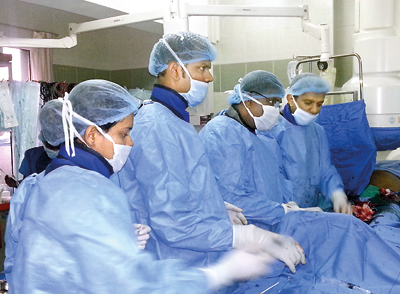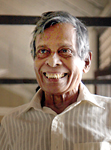EVAR for life
endovascular aortic aneurysm repair in Sri Lanka.
The tension was palpable. It was not that Consultant Vascular and Transplant Surgeon, Dr. Rezni Cassim, did not know what he was doing — for he had performed this life-saving procedure on numerous occasions in Australia where he had recently trained — but that the odds were heaped up against the patient.
It was the first-ever endovascular aortic aneurysm repair (EVAR) in Sri Lanka that the team was preparing for in a Catheterization Laboratory and not even an operating theatre.

The team performing EVAR
On the table that evening of October 30, was 80-year-old Alahakoone Mudiyanselage Dharmadasa Alahakoone from Kegalle, with the odds against survival very high.
Mr. Alahakoone was a “medical disaster” awaiting explosion. On October 3, an aneurysm in his aortic artery had ruptured, sending his pressure plummeting but later his condition had stabilized.
“Then too he was lucky to be alive,” concedes Dr. Cassim to MediScene, explaining that it would be a matter of time before the aneurysm rupture leaked again, bringing about “certain death”. He could not have open surgery for he could not be put under general anaesthesia as he had severe lung disease.
An aortic aneurysm is an abnormal bulge or ballooning in the wall of the aorta, according to Dr. Cassim, and Mr. Alahakoone’s aneurysm was about 1.5cm below the section from which the aorta channelled blood to the kidneys.
The aorta is the body’s largest artery which carries oxygen-rich blood from the heart down through the chest and abdominal (stomach) area and then divides into blood vessels going to the legs.
The EVAR procedure entailed sending C-arm (an imaging scanner intensifier) guided wires, over which were the stents, from Mr. Alahakoone’s groin area, through the femoral arteries to the site of the aneurysm.
The aneurysm didn’t have a straight neck but a 70 degree angulated one, says Dr. Cassim re-living the tension in the Cath Lab of the Asiri Surgical Hospital. “The placement of the stent was crucial. If the stent was placed too low over the aneurysm, it would slip into the aneurysm sack, while if it was placed too high it would obstruct the blood flow to the kidneys, causing them to shut down.”
In the two and a half hour procedure, the team also realized that additional stents were needed because the aneurysm neck was long.
While Mr. Alahakoone went home just 48 hours later, post-procedure he only had paracetamol for pain relief, says Dr. Cassim recalling the elation and euphoria of the team at the end, though much fatigued.
The statistics given by Dr. Cassim with regard to aortic aneurysms are deadly – when such an aneurysm becomes the size of 5.5cm, the risk of rupture (bursting) is great. In those who reach the hospital with a ruptured aneurysm, only 50% will survive, even if an operation is undertaken to repair it.
This is because there is life-threatening massive internal haemorrhaging and “all the blood goes out”, he explains, pointing out that it is lucky if an aneurysm is discovered before rupture during investigations such as routine scans.
In the case of a ruptured aneurysm, conventionally, surgery is performed to suture a graft to the top and bottom end of the aneurysm within the aorta. “This is a big operation, it’s open surgery and 5% would die. For the others, there would be a long recovery time with a prolonged hospital stay,” he said.
Some high-risk patients such as those suffering from severe heart, lung or kidney disease are not suitable to undergo surgery and they would literally be under a death sentence, awaiting the rupture of the aneurysm to die, MediScene learns.

With internationally such patients being saved by EVAR, it was his guru Prof. Mandika Wijeyaratne, Professor in Surgery, Colombo Medical Faculty who persuaded Dr. Cassim to go train in this field at the Royal Perth Hospital in Australia and bring back the skills for the benefit of Sri Lankans.
And then came Mr. Alahakoone, whose son was pleading with the doctors to save his life. It was to another guru, Prof. Anuja Abayadeera, Professor in Anaesthesiology, Colombo Medical Faculty, that he turned for crucial advice. “We’ll do it under local anaesthesia,” she assured, ever the “livewire”, he says.
The dangers, though were high – for a ruptured aneurysm could re-rupture causing a leak on the table and then the team which included Dr. Cassim, Prof. Wijeyaratne, Karapitiya Vascular and Transplant Surgeon Dr. Ranjuka Ubayasiri and Senior Registrar Dr. Joel Arudchelvam would have to convert EVAR to an emergency surgical operation, MediScene understands, with the need of very capable anaesthetists on hand. The anaesthetist team comprised Prof. Abayadeera and Dr. Aruna Shantha.
 Dr. Cassim: Elated with result |
 Grateful: The patient Mr. Alahakoone |
It was in the dedicated Cath Lab of Asiri Surgical Hospital offered by Asiri Group’s Chief Operations Officer, Dr. Manjula Karunaratne that the team undertook the procedure.
“The Head of Department Cath Lab, Vajira Muthucumarana, and his team went beyond the call of duty to support us,” says Dr. Cassim.
As we chat to Mr. Alahakoone last week, he says that during the procedure he felt pain for four seconds and once for about six seconds, but calls the doctors “devivaru who saved my life”. A CT scan to check out their handiwork has revealed that the EVAR procedure was “perfect”. There have been no endovascular leaks.
Follow @timesonlinelk
comments powered by Disqus






















